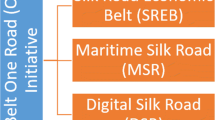Abstract
In recent years, the science of foresight has been entered into planning activities by urban and regional planners and this science has impacted on planning activities. This study discusses spatial development in the south of Bushehr province using the foresight approach. The general aim of this research is to compile scenarios for the development of the mentioned study area which comprises the southern part of Bushehr province including four counties of Dayyer, Jam, Kangan and Asaluyeh. The main reason for selecting this region is their direct impressibility by major changes in the country’s oil and gas industry. This research has extremely made use of the Delphi and cross-impact analysis methods to develop foresight scenarios. Using the Delphi method, 30 initial factors were identified in the economic, political-security, linkages, science and technology, manufacturing, natural, social, infrastructural and residential issues and then the cross-impact matrix was used to investigate the impact of factors on each other. In the next step, the ranking of direct and indirect factors was determined by Micmac software and on this basis, the final refining in the selection of drivers was done. In the final stage, axes of future scenarios were presented and then the future scenarios were drawn. Results of this research indicate that two main drivers namely Iran’s international relations and energy resources are the main axes of scenarios. These two drivers have more uncertainty and higher importance than other factors and the results in four scenarios showing the possibility of each situation’s occurrence.




Similar content being viewed by others
Notes
The Future Outlook of the Islamic Republic of Iran in the horizon of the next two decades.
A region in south-east of Iran.
References
Amuzegar, J. (2009). Iran’s 20-year economic perspective: Promises and pitfalls. Middle East Policy, 16(3), 41–57.
Asan, S. S., & Umut, A. (2007). Qualitative cross-impact analysis with time consideration. Technological Foresighting and Social Change, 74, 627–644.
Bradfielf, R., Wright, G., Burt, G., Cairns, G., & Heijden, K. V. D. (2005). The origins and evolution of scenario techniques in long range business planning. Futures, 37, 795–812.
Brown, B. (1968). Delphi process: A methodology used for the elicitation of opinions of experts. Santa Monica, CA: The RAND Corporation.
Chermack, T. J., Lynham, S. A., & Ruona, W. E. A. (2001). A review of scenario planning literature. Futures Research Quarterly, 17, 7–31.
Dalkey, N. (1969). Analyses from a group opinion study. Futures, 2(12), 541–551.
Dalkey, N., & Helmer, O. (1963). An experimental application of the Delphi method to the use of experts. Management Science, 9(3), 458–467.
Durance, P. (2010). Reciprocal influences in future thinking between Europe and the USA. Technological Forecasting and Social Change, 77, 1469–1475.
Durance, P., & Godet, M. (2010). Scenario building: Uses and abuses. Technological Forecasting and Social Change, 77, 1488–1492.
Enzer, S. (1971). Delphi and cross-impact techniques: An effective combination for systematic futures analysis. Futures, 3(1), 48–61.
Faludi, A., & Waterhout, B. (Eds.). (2002). The making of the European spatial development perspective. London: Routledge.
García, I., Peña-López, I., Johnson, L., Smith, R., Levine, A., & Haywood, K. (2010). Horizon report: 2010 Iberoamerican edition. Austin, TX: The New Media Consortium and the Universitat Oberta de Catalunya.
Gavigan, P. J., & Fabiana, S. (1999). Matching methods to the mission: A comparison of national foresight exercises. Foresight, 1(6), 495–517.
Godet, M. (1991). From anticipation to action. Paris: UNESCO Publishing.
Godet, M. (2000). Forefront: How to be rigorous with scenario planning. Foresight, 2, 5–9.
Godet, M. (2008). Strategic foresight. Lipsor working paper, France, Paris.
Gordon, T. J. (1994). Trend impact analysis. In Futures Research Methodology (pp. 1–19).
Heuer, R. J., & Pherson, R. H. (2014). Structured analytic techniques for intelligence analysis. (2nd Ed.). CQ Press.
Kahn, H., & Wiener, A. J. (1967). The year 2000: A framework for speculation on the next thirty-three years. New York: Macmillan.
Linstone, H., & Turoff, M. (1975). Introduction. In H. Linstone & M. Turoff (Eds.), The Delphi method: Techniques and applications. London: Addison-Wesley Publishing Company.
Loveridge, D. (2009). Foresight, the art and science of anticipating the future. New York: Routledge.
Martelli, A. (2001). Scenario building and scenario planning: State of the art and prospects of evolution. Futures Research Quarterly, 17, 57–70.
Nyiri, L. (2003). Foresight as a policy-making tool. In Technology foresight for organizers. 8–12 December, Training program in Ankara, Turkey.
Peterson, G. D., Cumming, G. S., & Carpenter, S. R. (2003). Scenario planning: A tool for conservation in an uncertain world. Conservation Biology, 17(2), 358–366.
Pillkahn, U. (2008). Using trends and scenarios as tools for strategy development. Erlangen: Publicis Corporate Publishing.
Rostamigooran, H., Esmailzadeh, F., Rajabi, R., Majdzadeh, B. Larijani, & Vahid Dastgerdi, M. (2013). Health system vision of Iran in 2025. Iranian Journal of Public Health, 42(Supple1), 18–22.
Schoemaker, P. J. H. (1995). Scenario planning: A tool for strategic thinking. Sloan Management Review, 36(2), 25.
Schoemaker, P. J. H., & van der Heijden, C. A. J. M. (1992). Integrating scenarios into strategic planning at Royal Dutch/Shell. Planning Review, 20(3), 41–46.
Slaughter, R. (1996). Knowledge base of futures studies. Melbourne: The Future Study Center.
Slaughter, R. (1999). Futures for the third millennium: Enabling the forward view. Sydney: Prospect Media.
Slaughter, R. (2007). Modernity for the new millennium, concepts, methods and ideas of futures study. Journal of futures studies, 12(1), 95–108.
Sotoca, A. (2016). Urban growth management in Catalonia, 2005–2010. Urban Research and Practice, 9(1), 91–102.
UNIDO. (1998). UNIDO technology foresight volume 2 technology foresight in action. Vienna: United Nation Industrial Development.
United Nations Industrial Development Organization (UNIDO). (2004). “Foresight methodologies”, textbook, technology foresight initiative. Vienna: Vienna International Centre.
Author information
Authors and Affiliations
Corresponding author
Rights and permissions
About this article
Cite this article
Abdoli, S., Habib, F. & Babazadeh, M. Making spatial development scenario for south of Bushehr province, Iran, based on strategic foresight. Environ Dev Sustain 20, 1293–1309 (2018). https://doi.org/10.1007/s10668-017-9940-x
Received:
Accepted:
Published:
Issue Date:
DOI: https://doi.org/10.1007/s10668-017-9940-x




